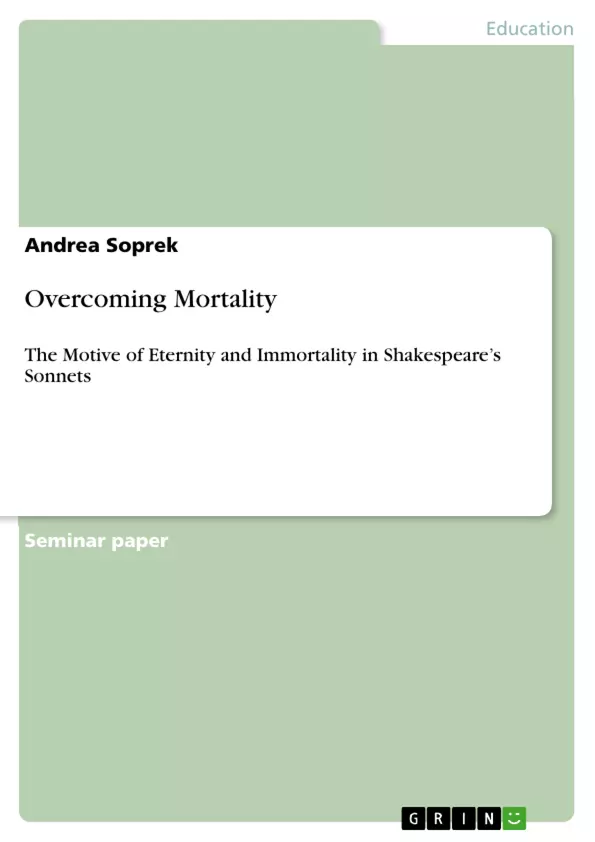The wish of overcoming mortality and gaining eternity is as old as the awareness of death. Many cultures and times have tried to succeed in this by various methods. Some built their dead enormous graves and buried their entire homes with them to guarantee a comfortable afterlife. Others mummified their corpses so that they might life forever. There is no religion that does not know the thought of afterlife, eternity or rebirth – be it the antique underworld Hades surrounded by the river Styx, the ancestor worship of many natural religions, the Buddhist belief of rebirth and incarnation or the Christian idea of eternal life in heaven or hell.
Besides the religious belief, however, there was another way for gaining eternity, especially in the upper classes of cultural western societies. They meant to gain eternity by creating something – a painting, sculpture or poem – that will last for centuries, perhaps for ever, and thus reminding the posterity of it’s creator. Some, however, used this method not for themselves but for others. They eternalised another person through their work of art for instance by praising the beauty or the virtues of a beloved or honoured person in verse. The main literal convention for doing so was the poem. Being a very common and possibly the greatest form for a love poem it is not surprising that the motive of giving immortality to the beauty of the beloved person is a very current motive in the sonnet, especially the Renaissance sonnet sequences. One of the greatest sonneteers in the English language, however, is one mostly known as the writer of plays like ‘Hamlet’, ‘Romeo and Juliet’, ‘King Lear’ and many, many others: William Shakespeare.
Inhaltsverzeichnis (Table of Contents)
- Overcoming Mortality
- Shakespeare as a Sonneteer
- The Shakespearean sonnet form
- The 'Fair Youth' and the 'Dark Lady'
- Differences to other sonnet sequences
- Immortalising trough poetry
- Sources of the motive
- The Greek and Roman poets
- The Italian and French poets
- Shakespeare's English predecessors
- Variations of the motive
- The 'verse-monument'
- The 'paper-and-ink' metaphor
- The 'heart-tomb'
- Sources of the motive
- Shakespeare's usage of the motive
- Pairs and Patterns among the sonnets dealing with the motive
- Introduction of the motive in sonnet XVI, XVII and XVIII
- Sonnets LXIV and LXV and sonnets LXXIII and LXXIV
- Sonnets C and CI
- Differences between Shakespeare and his Predecessors
- Shakespeare never immortalises himself
- Shakespeare is never proud and boasting
- Shakespeare never wants his friend to be grateful
- Variations of the motive used by Shakespeare
- The 'verse-monument'
- The 'paper-and-ink' metaphor
- The 'heart-tomb'
- The fight against time
- Sonnet XXXVIII
- The Objects to Shakespeare's eternisation
- Pairs and Patterns among the sonnets dealing with the motive
- Shakespeare's success in his aim to immortalise
Zielsetzung und Themenschwerpunkte (Objectives and Key Themes)
This seminar paper explores the motif of eternity and immortality in Shakespeare's sonnets. The paper aims to analyse Shakespeare's use of this motif, drawing comparisons to his predecessors in both classical and Renaissance poetry. The paper examines the sources of the motif, the variations on its implementation, and Shakespeare's unique approach to the theme.
- The motive of overcoming mortality through poetry
- The influence of classical and Renaissance poets on Shakespeare's work
- The different variations of the immortality motif, such as the "verse-monument" and "paper-and-ink" metaphor
- Shakespeare's unique treatment of the immortality motif, including his focus on personal relationships and the complexities of human emotions
- The impact of Shakespeare's sonnets on the legacy of the sonnet form and the exploration of human mortality.
Zusammenfassung der Kapitel (Chapter Summaries)
The paper begins by introducing the concept of overcoming mortality, noting its prevalence in various cultures and throughout history. It then moves on to explore Shakespeare's role as a sonneteer, outlining the Shakespearean sonnet form and introducing the key figures of the "Fair Youth" and the "Dark Lady". The paper delves into the origins of the immortality motif in poetry, examining its usage by Greek, Roman, Italian, and French poets, highlighting their individual approaches and motivations. The paper then delves into the various implementations of the immortality motif by Shakespeare, analyzing specific sonnets and identifying recurring patterns and themes.
Schlüsselwörter (Keywords)
This seminar paper focuses on the themes of mortality, immortality, and eternity within the context of Shakespeare's sonnets. Key concepts include the "verse-monument", "paper-and-ink" metaphor, and "heart-tomb" as expressions of the desire for enduring memory. The paper examines the influence of classical and Renaissance poets such as Horace, Petrarch, and Ronsard, alongside a discussion of Shakespeare's unique approach to the theme of love and the complexity of human relationships.
- Citation du texte
- Andrea Soprek (Auteur), 2007, Overcoming Mortality, Munich, GRIN Verlag, https://www.grin.com/document/161072



